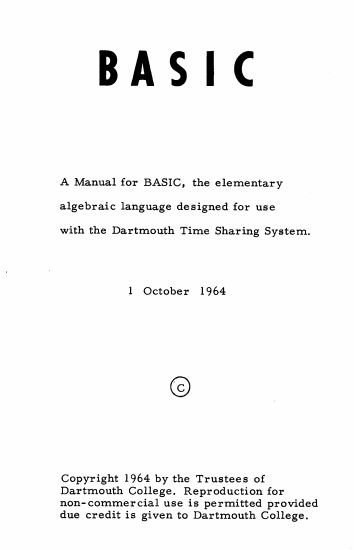| The Rise Of People Power - Computer Languages in the 1970's |
| Written by Harry Fairhead | ||||
Page 1 of 3
At the start of the 1970s computing and programming languages in particular looked well settled into a rut with Fortran, Algol and Cobol being the standards plus various specialist languages with small devoted bands of followers. However by halfway through the decade the personal computer had made its appearance and computing would never be the same again, no matter how much this displeased the established order. Even so there was a reaction and it would be too simple to say that the personal computer revolution and the language it called its own - BASIC - had it all its own way. Dartmouth BASICAlthough the rise of BASIC is very much a phenomenon of the mid 70's and early 80's it comes as something of a surprise to discover that it was actually born in the 60s. BASIC was designed by John Kemeny and Thomas Kurtz at Dartmouth College, in the USA, with a very different purpose in mind from the language creators of the 1950s and 1960s.
Kemeny and Kurtz Kemeny and Kurtz were interested in education. Dartmouth College was, and still is, a university in New England, USA, predominantly concerned with teaching the social sciences and humanities rather than the science that you might expect for the origins of any computer language. Almost by accident the college involved itself in computing from the early years and its main concern was finding ways of making computing accessible to its undergraduates. As part of this effort they created a number of languages - DARSIMCO, DART, SCALP and DOPE - but finally they arrived at the idea of implementing a time-sharing operating system plus language combination. The Dartmouth time-sharing system and BASIC - Beginners All-purpose Symbolic Instruction Code - came into being on May 1st 1964 at 4am! In many ways it is unfair to consider BASIC in isolation from its time-sharing environment. At the time nearly all computers were run in batch mode - you submitted your program, it was compiled, run to completion and only then did you see your output. Typical turnaround time on a small program was a day but many programmers would wait a week to see the results of their efforts.BASIC was different in that the time-sharing system allowed a BASIC program to be typed in and run in a few minutes. At first BASIC was modelled on the batch languages of the time in that all of the data that the program would process had to be included in a DATA statement before the program could be run. In 1966 the INPUT statement was added allowing the user to type in data while the program was running and BASIC had become a fully interactive language.
The aims of the BASIC system were:
These were very different aims to the ones adopted by the creators of Fortran, Algol and Cobol and their effect can be seen in the pragmatic nature of the language - if it worked simply and looked simple. As a result BASIC is mostly descended from Fortran because it has a simple structure and avoids nesting and recursion. Algol was mostly too technical and Cobol too verbose, although BASIC's FOR statement is borrowed from Algol because it is easier to read. The first version of BASIC had remarkably few statements: LET, PRINT, END, FOR, NEXT, GOTO, IF THEN, DEF, READ, DATA, DIM, GOSUB, RETURN and REM. The distinction between integer and real variables was abolished and variable were restricted to names consisting of a single letter or a single letter and a digit.
The first example of BASIC in its very first manual - "in most cases the purpose of each line in the program is self-evident" People argued for years over the rights and wrongs of each of these decisions but it is unarguable that the first version of BASIC met its objectives and was the first really useful teaching language and the first language to attempt `user-friendliness' even if it didn't wholly achieve it!
|
||||
| Last Updated ( Thursday, 31 December 2020 ) |




